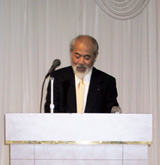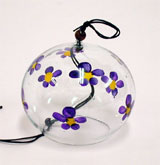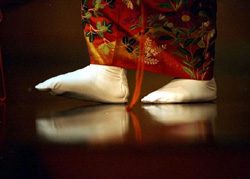|
|

|
keynote address

|
-
"Quietness" Viewed from Japanese Oriented Culture
Kenji Ekuan
Chairman / Japan Finland Design Association, GK Design Group
 The reason I proposed the theme "Quietness" for JFDA symposium was that the "nuance" of the word seemed so appropriate, in the midst of din presently surrounding us, to liberate our spirit from the chaos of our times. The reason I proposed the theme "Quietness" for JFDA symposium was that the "nuance" of the word seemed so appropriate, in the midst of din presently surrounding us, to liberate our spirit from the chaos of our times.
Urban noise has been created by modern conveniences, and buzzing sound of air crafts and cars are always one-sided. We often feel uneasiness physically and mentally. However, we never call the sound we want to listen to as noise. Even music becomes noise for us when we have no intention to listen to it but it really makes music when we intend to listen to it. If "soundless" is inquired by ourselves, the "soundless" can be said as it is well alive. It is important that what profound existence in our mind wanted the "soundless."
From old times, people have wanted something in the word "Quietness." We want to rely upon the word "Quietness," and to be embraced with the realities of "Quietness." That is because "Quietness" gives us comfort. Also while we have found ourselves having spent lazy time, we could face well focused ourselves by converging obscured self with embracing ourselves by a little coldhearted "Quietness." "Quietness" is a condition has to be created and it might never be given by someone else.
 Let us think about Japanese traditional wind bells. The sound of any wind bell is not bad at all. When a small piece of metal tip hang inside a spherically shaped glass shell hits the glass, it makes beautiful sound. The sound is really beautiful but that is it. However, when sound is produced by the wind bell hang from the eve submitted to natural breeze and the metal tip, a strip of paper being tied to it, hit the glass shell, it resonates absolutely different sound. The wind bell sound resonates in spurts tells spirit of breeze. The breeze is realized in formative expression. Just empty space becomes very lively thing. Mere soundless environment gives us just a sort of pressure but our spirit is softly wrapped with the beautiful wind bell sound created by the movement of the air. At that moment, our mind is relieved, and we forget fatuous selves for a little while. Then we could soak ourselves in the "Quietness" of relieved mind so to speak. Let us think about Japanese traditional wind bells. The sound of any wind bell is not bad at all. When a small piece of metal tip hang inside a spherically shaped glass shell hits the glass, it makes beautiful sound. The sound is really beautiful but that is it. However, when sound is produced by the wind bell hang from the eve submitted to natural breeze and the metal tip, a strip of paper being tied to it, hit the glass shell, it resonates absolutely different sound. The wind bell sound resonates in spurts tells spirit of breeze. The breeze is realized in formative expression. Just empty space becomes very lively thing. Mere soundless environment gives us just a sort of pressure but our spirit is softly wrapped with the beautiful wind bell sound created by the movement of the air. At that moment, our mind is relieved, and we forget fatuous selves for a little while. Then we could soak ourselves in the "Quietness" of relieved mind so to speak.
There are many uses of the wind bell. First, the wind bell sound resonated for a moment in the sweat oozing summer evening braces our mind loosened by the summer heat, and lets us feel the passing of breeze. This is a custom people enjoy hot and humid summer in Japan. It is called as a tool attracting cool air, and an excellent piece of design. There is also a wind bell made from metal. Itユs sound resonates longer and in higher tone, and attracts the quietness. Though it is totally being submitted to wind, the way it resonates sound by nature is philosophical and the genesis-like. The ultimate contact of nature and a man-made thing is excellently designed in it. Though the designer is unknown, our ancestors left a good thing for us. However, we have been in times now called as the age of no smell, no sound no germ, the wind bell hang from the eves is often accused and demanded to be taken off because some people insist that the sound annoys them. The wind bell is feared of extinction. The way we could use the wind bell varies in thousands, and it is advisable to negotiate with it in the intervals of our daily lives. It is heavenly resonance. It gives calmness to peoples' mind, and the mind is embraced with tranquil atmosphere. Even a wonderful tool inducing the "Quietness," an important thing is to try not to use them mistakenly.
The wind bell is like a cure-all for everyone, however, like a medicine dosed too late for a worsening disease, it wonユt work at all in the noise of cars and buzzing sound of aircrafts. Not only external noise but our frustrated feeling caused by human relationship and societies of times are also noise. In this case, we have to create the "Quietness" by some way else, and that is Zazen.
At the commemorative speech of the symposium, Zen master Eizan Goto beautifully explained the meaning of Zazen for us. There is a saying "the loneliness in the crowd," the author wants to assert that a saying "the quietness in noise" could be experienced through Zazen. The harder we try not to hear urban noise the louder we hear it. When we forget the five senses by meditation, our mind hear no noise though our ears hear it. More than that, spiritual comfort is born. Zen master Eizan asserted that anybody could get the comfort, though we might need certain practice for it, because the comfort by Zazen is obtained through self effort not external energy like the wind bell.
Human is a being with so many distresses. Civilized systems that human beings have created by themselves, a great variety of screams launched by the systems.
Noise from cars, aircrafts, trains, and more from the television, the radio, addressing of an election, we have been all annoyed. Those and these are all derived from human desire. The conflict between bodies and minds created religions, people want have spiritual peace. Either Christian churches or Buddhism temples have "Quietness" unique to them. It is a formative expression of the "Quietness" supporting its prayer. Worshippers try to soak their bodies into the "Quietness" and purify their bodies and souls. Not bad at all, they are very effective facilities. Humans are always irritated. Irritation is no good for all aspects. Human desires have enigmatic power generating irritation. Adults have adultsユ and children have children's. A fretting baby starts sleeping by hearing rhythmical sound. This is a popular scene. Buddhism has a bell called the "Kin" with high tone and longer resonant moment. When we sit in front of the Buddhism altar and ring the "Kin," curiously enough irritation is gone and our mind is invited to another world. The sound is extremely beautiful that resolves the irritation, and the spirit we seek after is being recreated. Because of its high tone, noise, irritation that is, condensed and frozen in a second, and a new stage is being set up for creating our spirit. By ringing it many times, long resonated sound gradually resolves the condensed spirit.
 Japanese tools for inducing "Quietness" often come with a device producing sound itself. Because more effective influence on everybody can be expected by tools or devices easier than stabilizing one's spirit by internal power. A Japanese traditional style tabor called the "Tsuzumi" is the kind. Its tense sound liberates ancient worriers' mind from all disturbing things and builds a white and spotless moment in their minds. The "Quietness" by its resonance beautifully fulfill their spirit, and they could be prepared for death. Because of its sharp tone, Tsuzumi sound is used for various expressions. It is an indispensable thing for subtle and profound Noh play. The Tsuzumi gives mind to the dance of Noh play that has extremely small move. By the combination, Noh mind starts from the more profound. The Audiences are then totally intoxicated by the rhythm of "move in still", "still in move." Japanese tools for inducing "Quietness" often come with a device producing sound itself. Because more effective influence on everybody can be expected by tools or devices easier than stabilizing one's spirit by internal power. A Japanese traditional style tabor called the "Tsuzumi" is the kind. Its tense sound liberates ancient worriers' mind from all disturbing things and builds a white and spotless moment in their minds. The "Quietness" by its resonance beautifully fulfill their spirit, and they could be prepared for death. Because of its sharp tone, Tsuzumi sound is used for various expressions. It is an indispensable thing for subtle and profound Noh play. The Tsuzumi gives mind to the dance of Noh play that has extremely small move. By the combination, Noh mind starts from the more profound. The Audiences are then totally intoxicated by the rhythm of "move in still", "still in move."
Now, the author has been considering about the quietness in sound in Japan. Trying to obtain the quietness through sipping a cup of tea is a tea ceremony on the other hand. The tea ceremony is the manner of the ultimate way seeking the "Quietness" that a tea master named Rikyu originated under the motto saying "harmony, respect, quietness." He advocated that the mind to respect people and to harmonize ourselves with nature is the destination through the "Quietness." He explained about excellence of the state by the manner called "Temae" in which peoples' mind is exchanged with respect to each other by offering a cup of tea. And a tea room, as a facility for Temae, is an ultimate artificial space built up for obtaining the quietness of mind quickly and effectively.
Although the author will need another opportunity to talk about a tea ceremony, best way to get to know it is actual experience like saying of seeing is believing. It can be said that a tea room is a comprehensive art that makes anybody possible to enjoy the comfort of the "Quietness." It can be defined as the way of challenge to the "Quietness" - tranquility that is an ultimate goal of human spirit through consolidation of architecture, craft, fine art, calligraphy, incense, flower arrangement, culinary, landscape plan and Noh play. This is a very consolidation of design. Rikyu called it as "harmony, respect and quietness."
Though the author has made various expressions, it has been found that a theme of the "Quietness," set up by the design team of Japan and Finland, has very deep meaning. This is the theme we should seek after throughout our life. It is so wonderful that both Japanese and Finnish peoples have some thoughts in common. This might be said as just matched feeling for each other.
 Secretariat
Secretariat
Japan Finland Design Association (Japan)
c/o The Finnish Institute in Japan
3-5-39 Minami Azabu, Minato-ku, Tokyo, Japan 106-8561

c/o GK Graphics Incorporated
telephone : 03-5952-6831 facsimile : 03-5952-6832
e-mail : jfda@gk-design.co.jp
previous
| |
|
